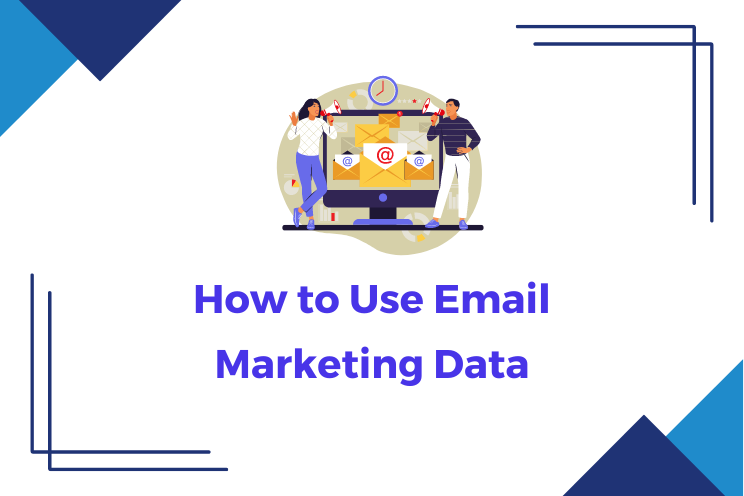Here’s the reality: If you’re not using data to drive your email marketing strategy, you’re leaving a lot of money on the table.
Email marketing isn’t just about blasting messages to a list and hoping for the best. It’s about understanding what your data tells you and using it to make smarter decisions that get results.
Whether you’re trying to boost open rates, increase conversions, or understand customer behavior, your email marketing data holds the key. But only if you know how to use it.

Understanding Email Marketing Metrics
Let’s get one thing straight: Not all metrics are created equal. You need to know which ones matter and how to interpret them.
Key Metrics to Track
When it comes to email marketing, there are a few metrics that you absolutely need to monitor. Open rates tell you how many people are actually looking at your emails. Click-through rates (CTR) show you how many of those people are engaging with your content. Conversion rates indicate how many of those clicks are turning into sales, sign-ups, or whatever your goal may be. And don’t forget about unsubscribe rates—they’re your early warning system for when your content isn’t hitting the mark.
Engagement Metrics
Engagement isn’t just about clicks. It’s about how your audience interacts with your emails overall. This includes metrics like engagement time (how long they spend reading), bounce rates (emails that don’t reach the inbox), and forward rates (how often your content is shared). High engagement means your content resonates, while low engagement is a red flag that something needs to change.
Using Data for Customer Segmentation
If you’re not segmenting your audience, you’re basically throwing darts in the dark. Segmentation is how you make sure your message hits the right people at the right time.
Segmenting Your Audience Based on Behavior
Data-driven segmentation allows you to target your emails to specific groups within your audience. Use data like past purchase history, browsing behavior, and demographic information to create segments that are more likely to engage with your content. For example, if someone consistently clicks on your emails but never buys, consider sending them a special offer to close the deal.
Personalizing Content with Data
People respond to content that feels like it was made just for them. Use your data to personalize emails based on the recipient’s behavior, preferences, and history. Personalized subject lines can increase open rates, while personalized offers can boost conversions. The more tailored your content, the more effective it will be.
Optimizing Email Campaigns with A/B Testing
You can’t just guess what’s going to work. That’s why A/B testing is so critical.
Setting Up A/B Tests Using Data
Start by identifying what you want to test—subject lines, email copy, images, or CTAs. Use your existing data to set up these tests.
For example, if you notice that emails sent at a certain time have a higher open rate, test sending emails at different times to see if you can optimize further. Remember, the key to A/B testing is to change one variable at a time so you know what’s driving the results.
Interpreting A/B Test Results
Once your tests are complete, it’s time to dive into the data. Look for statistically significant differences between your variations. Did one subject line lead to a higher open rate? Did a particular CTA result in more conversions?
Use these insights to refine your strategy and improve future campaigns. And don’t stop testing—continuous improvement is the name of the game.
Predictive Analytics in Email Marketing
Why react to what’s already happened when you can predict what’s going to happen? That’s where predictive analytics comes in.
Using Predictive Analytics to Forecast Trends
Predictive analytics uses your existing data to forecast future behavior. For example, by analyzing past purchase data, you can predict when a customer is likely to buy again and send them a timely email to encourage that purchase. This proactive approach helps you stay ahead of the curve and drive more sales.
Applying Predictive Models to Email Campaigns
Integrating predictive models into your email marketing can help you automate and optimize campaigns. For instance, if a model predicts that a subscriber is likely to churn, you can trigger a re-engagement campaign automatically. This kind of data-driven automation ensures you’re always taking the right action at the right time, without the guesswork.
Improving Campaign Performance with Data Integration
Email marketing doesn’t exist in a vacuum. To get the full picture, you need to integrate your email data with other channels.
Integrating Email Data with Other Marketing Channels
By combining email marketing data with data from social media, paid ads, and website analytics, you can create a more comprehensive view of your customer’s journey. This holistic approach allows you to tailor your email campaigns based on interactions across different channels, leading to more cohesive and effective marketing efforts.
Using Data for Cross-Channel Marketing
Cross-channel marketing is about creating a seamless experience for your audience, no matter where they interact with your brand. Use email marketing data to inform your strategies on other channels.
For example, if a customer clicks on a product in your email but doesn’t purchase, retarget them with a social media ad for that same product. This kind of data-driven synergy can significantly increase your chances of converting leads into customers.
Case Studies: Success Stories in Data-Driven Email Marketing
Let’s talk about what happens when you actually apply these strategies. Real-world examples can show you what’s possible.
Case Study 1: E-Commerce Brand
An e-commerce brand used customer segmentation to tailor their email campaigns. By targeting specific segments with personalized offers, they increased their conversion rates by 35%. The lesson? Segmentation works—especially when it’s data-driven.
Case Study 2: SaaS Company
A SaaS company implemented A/B testing to optimize their onboarding emails. By testing different subject lines and CTAs, they reduced their churn rate by 20%. The takeaway? Even small changes can have a big impact when you base them on data.
Case Study 3: Retailer
A retailer integrated their email marketing data with their social media campaigns. By targeting customers who engaged with their emails but didn’t purchase, they increased their return on ad spend by 50%. The key takeaway? Data integration creates powerful cross-channel marketing opportunities.
FAQs
What are the most important email marketing metrics to track?
Key metrics include open rates, click-through rates (CTR), conversion rates, and unsubscribe rates. These metrics provide insights into how your audience interacts with your emails.
How can I use data to personalize my email content?
Use customer data such as past behavior, preferences, and purchase history to create personalized emails. Tailored subject lines and content can significantly improve engagement.
What is A/B testing in email marketing?
A/B testing involves sending two variations of an email to see which performs better. It’s a critical tool for optimizing email campaigns based on data-driven insights.
How can predictive analytics improve my email marketing?
Predictive analytics uses historical data to forecast future behavior. This allows you to anticipate customer needs and automate responses, improving engagement and conversion rates.
Why is data integration important in email marketing?
Integrating email data with data from other channels gives you a comprehensive view of customer behavior, enabling more effective cross-channel marketing and better overall campaign performance.
Conclusion
Using email marketing data isn’t just about tracking numbers—it’s about understanding what those numbers mean and how to use them to drive results. Whether it’s through segmentation, A/B testing, predictive analytics, or data integration, your email marketing success hinges on your ability to leverage data effectively.
So start digging into your data, apply these strategies, and watch your email campaigns go from good to great.
